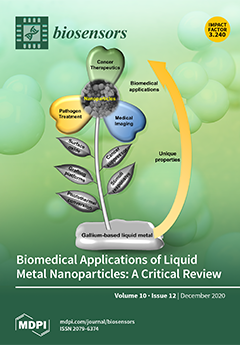The current work demonstrates an electrochemical aptasensor for sensitive determination of Cd
2+ based on the Ti-modified Co
3O
4 nanoparticles. In this unlabeled system, Ti-modified Co
3O
4 nanoparticles act as current signal amplifiers modified on the screen-printed carbon electrode
[...] Read more.
The current work demonstrates an electrochemical aptasensor for sensitive determination of Cd
2+ based on the Ti-modified Co
3O
4 nanoparticles. In this unlabeled system, Ti-modified Co
3O
4 nanoparticles act as current signal amplifiers modified on the screen-printed carbon electrode (SPCE) surface, while the derivative aptamer of Cd
2+ works as a target recognizer. In addition, the sensing is based on the increase in electrochemical probe thionine current signal due to the binding of aptamer to Cd
2+ via specific recognition. In the current study, key parameters, including aptamer concentration, pH, and incubation time were optimized, respectively, to ensure sensing performance. Cyclic voltammetry was used not only to characterize each preparation and optimization step, but also to profile the bindings of aptamer to Cd
2+. Under optimal conditions, Cd
2+ can be determined in a linear range of 0.20 to 15 ng/mL, with a detection limit of 0.49 ng/mL, significantly below the maximum concentration limit set by the U.S. Environmental Protection Agency. Based on comparative analysis and the results of recovery test with real samples, this simple, label-free but highly selective method has considerable potential and thus can be used as an in-situ environmental monitoring platform for Cd
2+ testing.
Full article






